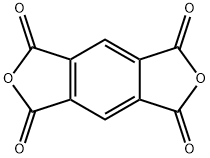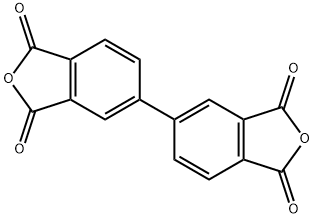A6688712
Pyromellitic dianhydride , 99% , 89-32-7
Synonym(s):
1,2,4,5-Benzenetetracarboxylic-1,2:4,5-dianhydride;Benzene-1,2,4,5-tetracarboxylic dianhydride;PMDA;Pyromellitic dianhydride
CAS NO.:89-32-7
Empirical Formula: C10H2O6
Molecular Weight: 218.12
MDL number: MFCD00005005
EINECS: 201-898-9
Update time: 2022-07-08
PRODUCT Properties
| Melting point: | 283-286 °C(lit.) |
| Boiling point: | 397-400 °C(lit.) |
| bulk density | 400-600kg/m3 |
| Density | 1,68 g/cm3 |
| vapor pressure | 0Pa at 25℃ |
| refractive index | 1.6000 (estimate) |
| Flash point: | 380 °C |
| storage temp. | 2-30°C |
| solubility | Soluble in dimethyl sulfoxide, acetone, chloroform, ethyl ether, n-hexane and benzene. |
| form | Fine Powder |
| pka | 5.45[at 20 ℃] |
| color | White to pale yellow |
| Water Solubility | decomposes |
| Sensitive | Moisture Sensitive |
| BRN | 213583 |
| InChIKey | ANSXAPJVJOKRDJ-UHFFFAOYSA-N |
| LogP | -2.03 at 21.5℃ |
| CAS DataBase Reference | 89-32-7(CAS DataBase Reference) |
| NIST Chemistry Reference | 1,2,4,5-Benzenetetracarboxylic anhydride(89-32-7) |
| EPA Substance Registry System | 1H,3H-Benzo[1,2-c:4,5-c']difuran-1,3,5,7-tetrone (89-32-7) |
Description and Uses
Pyromellitic dianhydride is used as a monomer in the preparation of polyimide polymers such as kapton; thermoplastics such as polyesters, polyethers, plasticizers, and expoxy resins. It is involved in the preparation of high performance coatings due to its mechanical, thermal and oxidative stability properties. It acts as a curing agent for epoxy resins which find application in adhesives, coatings and molding powders. As an intermediate, it plays an important role in polyimide based materials like printed circuit boards, tape automated bonding and magnetic wire insulation.
Safety
| Symbol(GHS) |   GHS05,GHS08 |
| Signal word | Danger |
| Hazard statements | H317-H318-H334 |
| Precautionary statements | P261-P272-P280-P284-P302+P352-P305+P351+P338 |
| Hazard Codes | Xn |
| Risk Statements | 41-42/43 |
| Safety Statements | 22-24-26-37/39 |
| WGK Germany | 1 |
| RTECS | DB9300000 |
| F | 10-21 |
| Autoignition Temperature | 630°C |
| TSCA | Yes |
| HS Code | 29173980 |
| Hazardous Substances Data | 89-32-7(Hazardous Substances Data) |



